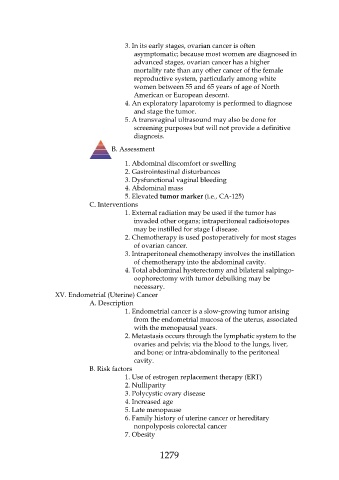Page 1279 - Saunders Comprehensive Review For NCLEX-RN
P. 1279
3. In its early stages, ovarian cancer is often
asymptomatic; because most women are diagnosed in
advanced stages, ovarian cancer has a higher
mortality rate than any other cancer of the female
reproductive system, particularly among white
women between 55 and 65 years of age of North
American or European descent.
4. An exploratory laparotomy is performed to diagnose
and stage the tumor.
5. A transvaginal ultrasound may also be done for
screening purposes but will not provide a definitive
diagnosis.
B. Assessment
1. Abdominal discomfort or swelling
2. Gastrointestinal disturbances
3. Dysfunctional vaginal bleeding
4. Abdominal mass
5. Elevated tumor marker (i.e., CA-125)
C. Interventions
1. External radiation may be used if the tumor has
invaded other organs; intraperitoneal radioisotopes
may be instilled for stage I disease.
2. Chemotherapy is used postoperatively for most stages
of ovarian cancer.
3. Intraperitoneal chemotherapy involves the instillation
of chemotherapy into the abdominal cavity.
4. Total abdominal hysterectomy and bilateral salpingo-
oophorectomy with tumor debulking may be
necessary.
XV. Endometrial (Uterine) Cancer
A. Description
1. Endometrial cancer is a slow-growing tumor arising
from the endometrial mucosa of the uterus, associated
with the menopausal years.
2. Metastasis occurs through the lymphatic system to the
ovaries and pelvis; via the blood to the lungs, liver,
and bone; or intra-abdominally to the peritoneal
cavity.
B. Risk factors
1. Use of estrogen replacement therapy (ERT)
2. Nulliparity
3. Polycystic ovary disease
4. Increased age
5. Late menopause
6. Family history of uterine cancer or hereditary
nonpolyposis colorectal cancer
7. Obesity
1279

